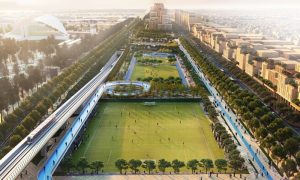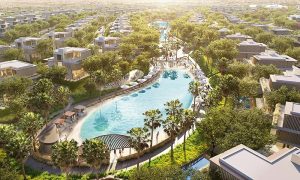The ripple effect of Saudi Arabia’s construction boom
Real estate insight by Barry O’Reilly, Head of Project Management, Project & Development Services UAE, JLL

Since the launch of Saudi Arabia’s ‘Giga projects’ as part of its ‘Vision 2030’ economic diversification scheme, the kingdom has emerged as a key driver in the construction sector in the Middle East. In fact, 39% of the Middle East and Africa (MENA) project pipeline is in KSA, with activity forecast to experience 4% growth each year between 2024 and 2027. According to the Saudi Contractors Authority (SCA), the building and construction sector contributes 6% to GDP, making it the second-largest non-oil sector in the country.
While it presents unprecedented economic opportunities for KSA and the region, the high concentration of multiple colossal development projects, at various design and development stages, has strained the construction activities of the nation and neighbouring countries. This includes mature markets like the UAE, where the demand for talent and staff retention has intensified, and the supply chain pressures have increased. As a result, businesses must rethink their operating models and project delivery approach to remain competitive.
Talent acquisition and retention
Staff retention in the UAE has become a major challenge, due to the highly competitive salaries, benefits, and compensation packages offered to attract talent to Riyadh. According to the Ministry of Finance’s 2024 budget statement, the Kingdom of Saudi Arabia has created 1.12 million jobs in the private sector to meet project demand.
In the past, working in KSA was more niche: it traditionally attracted young, single individuals who were willing to earn a higher salary and gain experience working on some of the world’s most ambitious and exciting projects.
However, with the country’s rapid modernisation and social changes in recent years, cities like Riyadh and Jeddah are becoming more attractive to expats, with shopping malls, restaurants, parks, sports facilities, and recreational amenities; they are attracing an increasing volume of talented and experienced indivduals, who now feel happy to relocate their families.
Developers and contractors in Saudi are also placing increased pressure on staff to live in the Kingdom, thereby reducing the opportunities for staff to base themselves in the UAE and commute to KSA on a ‘fly in, fly out’ basis.
The increased attraction from KSA is creating challenges around the retention of key staff, as well as inflating salary levels in Dubai and Abu Dhabi. Companies need a new approach to talent acquisition, rewards and performance to retain their business advantage. For years, companies in the region have been vying for the same limited pool of qualified professionals. However, in the Middle East, there exists an incredibly diverse population in terms of nationality, race, ethnicity, age, and experience, which represents a significant untapped talent pool. Unfortunately, this potential is often overlooked due to gender, racial or age stereotyping stemming from deeply ingrained cultural norms and societal expectations.
Moreover, implementing transparency and merit-based compensation packages and fostering an inclusive work environment that prioritises employee satisfaction can significantly contribute to talent retention. Companies can make investments in training and development to upskill their workforce and enhance employee engagement.
Mitigating supply chain pressures
Pressure on the global supply chain has been an issue since the COVID-19 pandemic and has been prolonged by recent cross-border conflicts in the Eastern and Middle East regions. As a result, there have been delays caused by the closure of trade routes, a surge in demand for locally sourced products, and escalating prices.
The increasing demand for construction materials for Saudi Arabia’s giga-projects has further intensified competition, raised prices, and extended project timelines in the UAE. These demand and supply challenges, coupled with ambitious project schedules across the region, have led to resource scarcity and rationing.
However, it is important to note that this situation is likely temporary, and efforts are being made to streamline the supply of locally sourced materials within Saudi Arabia through prefabrication and modular construction. In the meantime, many materials initially allocated for the UAE are being redirected to the larger projects in Saudi Arabia.
To reduce the impact of supply chain disruptions, companies must get around what’s traditionally been their way of approaching supply chain and manufacturing. Apart from diversifying suppliers and developing contingency plans, technology adoption for real-time tracking of shipments and inventory levels can provide insights to anticipate and mitigate disruptions.
Consider repurposing or recycling existing and surplus construction materials to reduce the strain on natural resources and decrease the industry’s reliance on raw materials procurement, while simultaneously fostering a more eco-friendly and resilient sector. Rather than disposing of used or excess materials in landfills, the establishment of green building material exchanges enables construction companies to engage in buying, selling, or donating these materials. This approach not only extends the lifespan of materials but also promotes the circular economy, encouraging resource conservation and minimising waste. By embracing these practices, the construction industry can also make significant strides towards a more sustainable future.
Greener and more human-centric developments
The implications of these cost increases in the construction sector resulting from increase in labour and material costs presents a unique opportunity for innovation and differentiation. Developers are staying ahead by integrating cost-saving measures and sustainable practices into their projects to attract a new segment of investors and buyers.
This includes repurposing ageing or underperforming buildings and focusing on creating sustainable, inclusive communities with a focus on wellness. These initiatives are driven by an emphasis on improving residents’ overall quality of life.
By reusing existing structures, developers can preserve architectural heritage and reduce reliance on new construction, benefiting both the environment and their bottom line while increasing speed to market.
Additionally, community developments prioritise connectivity, featuring walkable neighbourhoods that promote social interaction and provide easy access to amenities. These developments are designed to cater to changing lifestyle preferences and are expected to have high demand and long-term sustainability.
Conclusion
While Saudi Arabia is expected to maintain its influence on the region’s construction activities, the UAE market remains immensely appealing to real estate investors and individuals choosing the UAE as their permanent residence. Accodring to JLL’s UAE Construction Market Intelligence Q1 2024 report, the UAE stands out with a high-value pipeline of USD590 billion in the Middle East and North Africa’s projects market, with residential projects accounting for USD125 billion (21%), and mixed-use projects representing USD232 billion (39%).























